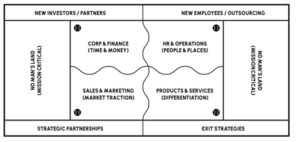
Every entrepreneur needs an anchor — something that helps them find balance and make sense of the chaotic, uncharted world of startups. For me, that anchor is tennis. It’s more than just playing a tennis match. I map my mental chatter onto the court and translate it into the world of entrepreneurship — or the world in general. Tennis has given me a framework to quantify the unquantifiable, to navigate uncertainty, and to elevate my business game. I’ve learned to apply tennis analogies and metaphors to up my business game.
Whether or not you play tennis, you can navigate your startup — or your business — using the same principles. You can learn how to apply a tennis mindset to the startup game using these strategies:
Score your startup match.
When I step onto the tennis court, a realm materializes for me where the universe aligns and a semblance of order prevails. There are rules. There are strategies. There are tactics. There is an opponent. There are boundaries. Most of all, there’s hope: a match is never over until it’s over. No matter what the score is, no matter how many points you are losing or winning by, things can turn around in an instant in this game. We’ve all seen incredible comebacks.
So, when you need to make some big decisions in your business, or evaluate priorities, to absorb a big setback, place yourself on a tennis court. First you need to figure out what the score of your startup match really is. Are you winning or losing? What set is it? Are you serving, or returning? Is it break point, set point, or are you close to facing a match point? Depending on the situation, there are times to play it safe — and then there are times to pull the trigger and go for that winning low-percentage shot.
Let your competitive mind take over.
In the face of potential defeat, I let my competitive tennis mind take control. It’s the mindset of a survivor and strategist. “It’s just a double fault,” I tell myself. “Focus on the next point. No was. No next. Just here and now.” If it’s all going wrong, I start self-coaching, reminding myself that it’s just one tennis match, just one tournament, no big deal. Remember: even Roger Federer and Rafael Nadal have bad tournaments. Then I push myself to get up and move. Move your feet, let’s go! Go!
Divide the service boxes into mission-critical quadrants.
Startups can feel overwhelming, with endless action items pulling you in different directions. One way to make sense of it all is to visualize each business unit as a quadrant on the court. Think of them as four service boxes of a tennis court:
- Corporate and Finance: How much time and money do you have?
- HR and Operations: What are the key personnel and operational priorities?
- Products and Services: What are the product/service roadmaps and differentiation?
- Sales and Marketing: What’s the sales pipeline/funnel and what’s the marketing status?
Recognize that everything’s connected.
To underscore the interconnectedness of each department, I use squiggly lines between the quadrants instead of straight ones. No one department stands in isolation. Each forms a part of the startup puzzle. If we talk about product development budgets without concurrently considering sales and marketing initiatives, we’re not seeing the full picture. When I’m in management strategy sessions, I’ll veer away from the conventional outline approach and present these quadrants as a blueprint to structure discussions and ensure alignment.
Focus on the next essential action item.

Within each quadrant, I circle the one mission-critical action item that must happen before the next meeting. Entrepreneurs are both risk-takers and risk managers. The good ones can handle mission-critical decisions that are made on incomplete information, while maintaining equilibrium across the quadrants.
Watch out for challenges and X-factors.
Behind closed doors, I expand these service boxes into an entire tennis court, envisioning the holistic scenario — the score of the overarching match. The area between the service line and the baseline is a no-man’s-land filled with challenges: cash flow crunches, market shifts, and operational fires. Stepping into this territory is where games are lost; it’s like finding oneself in the dire straits of being unable to make payroll or missing pivotal performance targets.
Don’t forget the exit strategy.
The alleys alongside, on the other hand, translate into my long-term parking lot items, which demand continuous vigilance: new investors/partners, new employees/outsourcing, strategic partnerships, and above all, exit strategies. These are all important but not always urgent. By drawing out this tennis court map of your startup, you give yourself control over what you are doing — or at least the perception of control — so you can stay organized and effective. Just like a tennis match, the objective of beginning a startup is to end it … one way or the other, the match will be over.
Step onto a real court.
Sometimes I have a profound experience by just stepping onto a tennis court. When my head is filled with business metrics and challenges, and I feel paralyzed because I can’t make payroll for my employees, or I’m in a lose-lose situation regarding an important mission critical decision, I step onto a court — usually alone, with my racquet and one tennis ball. Standing at the baseline, looking across the net, I can feel myself detach from the confines of a startup’s 3-D reality. I’ve even had out of body experiences — feeling like the character Neo in the movie Matrix: the tennis court transforms into a new dimension, a spectrum of all business challenges floating in the air. Those KPI’s, hiring decisions, key negotiations in motion, investor presentations on the horizon — all hover above the court in front of me.
I step onto the edge of the baseline, look across the net, and imagine I’m facing my startup opponent. I’m ready to serve. I can sense the universe getting into alignment. All these decisions seem to gently fall onto the court, placing themselves in their quadrant. Then I can see that one target I need to hit. That one step I need to take. That one action item. All that matters is that next point.
Find Your Own Game
Decades in the startup trenches have taught me that no amount of preparation guarantees success. No matter how hard you work, no matter how much time and effort you invest, no matter how many boxes you have checked regarding your product, team, and funding, there are myriad factors outside your control that ultimately determine success or failure. Many of those remain outside your grasp and influence.
The key is to shift perspectives — to map challenges in a new light. Tennis does it for me. But everyone has their own game. Find yours, and use it to create your own framework.


Be the first to comment